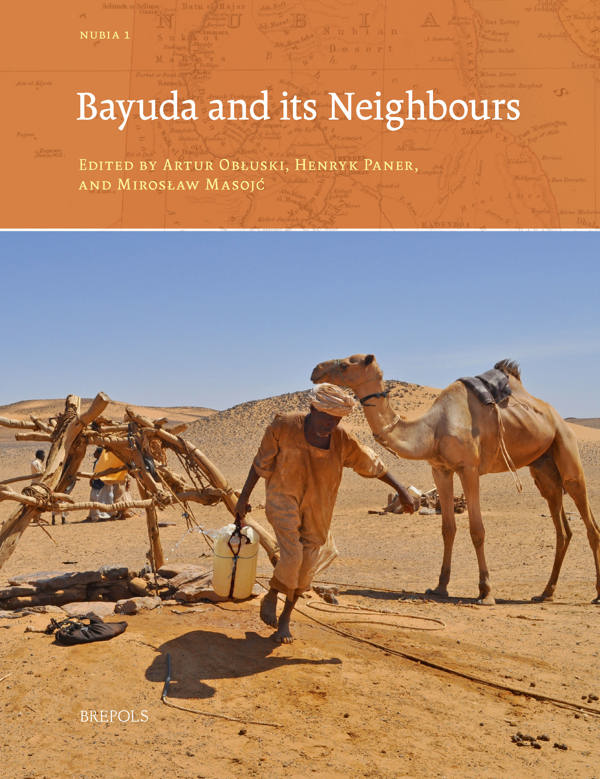
Bayuda and its Neighbours
Artur Obłuski, Henryk Paner, Mirosław Masojć (eds)
- Pages: 200 p.
- Size:216 x 280 mm
- Illustrations:75 b/w, 49 col., 5 tables b/w., 12 maps b/w
- Language(s):English
- Publication Year:2021
- € 70,00 EXCL. VAT RETAIL PRICE
- ISBN: 978-2-503-59906-9
- Paperback
- Available
- ISBN: 978-2-503-59907-6
- E-book
- Available
Artur Obłuski is an archaeologist and expert in Nubiology, with particular interests in Nubian monasticism and social and religious transformations in Northeast Africa and the Near East. He has headed an archaeological expedition to Old Dongola and Ghazali in Sudan. He is the first Polish archaeologist to receive a grant from the European Research Council (ERC Starting Grant),snf id the President of the International Society for Nubian Studies and Head of the Polish Centre of Mediterranean Archaeology, University of Warsaw. He promotes the idea of socially responsible archaeology and the engagement of local communities in cultural heritage management.
Henryk Paner has been conducting archaeological research in Sudan since 1993. He managed projects in Old Sennar, Jebel Querri and Awalib, and between 1996 and 2008 he was the project director of the Gdańsk mission to the Fourth Cataract. Since 2009 he has been the manager of the Bayuda Project. Currently he works at the Polish Centre of Mediterranean Archaeology, University of Warsaw, and directs the African Department at the Archaeological Museum in Gdańsk.
Mirosław Masojć (PhD 2002, University of Wroclaw, Poland) is an Associate Professor at the Institute of Archaeology of the University of Wroclaw, Poland. His principal research interests lie in studying Pleistocene and early Holocene hunter-gatherers in Europe and Northeast Africa, and flint knapping in the Late Bronze Age.
The Bayuda, although an arid desert located in modern-day Sudan, has nonetheless been inhabited, farmed, worshipped in, and fought over by humans from the Palaeolithic onwards. Yet despite the longevity of its human occupation, the region has only in recent years become the focus of more intensive scholarly research. This volume, the first in a series dedicated to exploring the archaeology and history of Northeast Africa, aims to build on this trend by drawing together the very latest archaeological research and data, and shedding light on how the Bayuda Desert and its environs were transformed into a cultural landscape. The contributions gathered here introduce, examine, and (re)assess a number of important issues, many of which are new in the archaeology of Nubia, as well as considering them against a broader comparative background. From climate change over the past millennia — and its far-reaching consequences in the present — through to an examination of the cultural influences of the Kingdom of Kerma, and from analysis of funeral rites through to interpretations of rock art, forgotten trade routes, and the commerce in cattle and slaves, this insightful volume offers a wealth of new information into the history of ancient Nubia.
Introduction — ARTUR OBŁUSKI, HENRYK PANER, AND MIROSŁAW MASOJĆ
Considerations on Terminologies: Based on Data from the Wadi Abu Dom — TIM KARBERG AND ANGELIKA LOHWASSER
Archaeological Heritage of the Bayuda Desert: An Attempt at Evaluating the Project. Introductory Remarks — HENRYK PANER
The Kingdom of Kerma between Egypt and Central Africa — CHARLES BONNET
Cattle in the Nile Fourth Cataract Rock Art: El-Gamamiya 67 Site as an Example — PAWEŁ L. POLKOWSKI
Anthropological Analysis of Human Skeletal Remains from the Old Kush–New Kingdom Cemetery (BP164) in the Bayuda Desert, Sudan — ALEKSANDRA PUDŁO
Meroe and the Moving Nile — M. D. S. MALLINSON AND L. M. V. SMITH
The Natural and Cultural Landscape of the Meroe Region — PAWEL WOLF
The Archaeology of the Sabaloka Region — FAWZI HASSAN BAKHIET
Makuria Deserta. Some Observations on the Changing Pattern of Desert Trails in the Western Bayuda Desert and its Impact on the History of the Region — BOGDAN T. ŻURAWSKI


